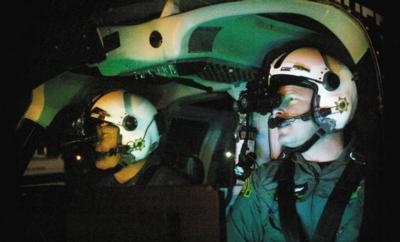Mon, Oct 01, 2018
Emphasizes The Importance Of Incorporating Procedures For The Avoidance Of Obstacles Marked With LED Obstruction Lights During NVG Operations
A helicopter-air-ambulance pilot utilizing NVGs recently reported a near miss with a tower marked with LED obstruction lighting. This may have occurred because some LED lighting systems fall outside the combined visible and near-infrared spectrum detected by NVGs. An unaided crewmember saw the tower that was not seen by the pilot utilizing NVGs.

In 2009, the FAA issued SAFO 09007, Night Vision Goggle (NVG) Advisory Pertaining to Certain Red Color Light Emitting Diodes (LED). The SAFO advised operators using NVGs that certain LED lighting systems fall outside the combined visible and near-infrared spectrum of NVGs, and thus will not be visible to flightcrew using NVGs. It recommends pilots be advised of the limitations associated with LED obstruction lighting and that such information be incorporated into the pilot NVG training programs.
The FAA now adds an additional recommendation that air carriers/operators and Title 14 of the Code of Federal Regulations Part 91 operators that utilize NVGs incorporate procedures into manuals and/or SOPs that require periodic unaided scanning when operating at low altitudes and when performing a reconnaissance of landing areas. This may be accomplished by looking under or to the sides of the NVGs or by briefly placing the NVGs in the stowed (flipped-up) position. Manuals/SOPs should include crew-resource management procedures for addressing LED-lit obstructions to the pilot flying. For instance, non-flying personnel should make periodic unaided scans and “point out” the obstruction(s) to the pilot, e.g. “LED lit tower, two o’clock”. It is also recommended that a landing be aborted and/or a climb to a higher altitude be initiated any time the location of an obstruction is not clear to the pilot.
Airplane and rotorcraft operators and pilots should familiarize themselves with the information contained in this SAFO. In addition, operators and pilots are encouraged to report encounters with obstructions marked with non-NVG compatible LED lighting systems, with pertinent information, to the Aviation Safety Reporting System.
(Image from file)
More News
He Attempted To Restart The Engine Three Times. On The Third Restart Attempt, He Noticed That Flames Were Coming Out From The Right Wing Near The Fuel Cap Analysis: The pilot repor>[...]
Make Sure You NEVER Miss A New Story From Aero-News Network Do you ever feel like you never see posts from a certain person or page on Facebook or Instagram? Here’s how you c>[...]
From 2009 (YouTube Edition): Leading Air Show Performers Give Their Best Advice for Newcomers On December 6th through December 9th, the Paris Las Vegas Hotel hosted over 1,500 air >[...]
Aero Linx: NASA ASRS ASRS captures confidential reports, analyzes the resulting aviation safety data, and disseminates vital information to the aviation community. The ASRS is an i>[...]
“For our inaugural Pylon Racing Seminar in Roswell, we were thrilled to certify 60 pilots across our six closed-course pylon race classes. Not only did this year’s PRS >[...]
 NTSB Final Report: Rutan Long-EZ
NTSB Final Report: Rutan Long-EZ ANN FAQ: Turn On Post Notifications
ANN FAQ: Turn On Post Notifications Classic Aero-TV: ICAS Perspectives - Advice for New Air Show Performers
Classic Aero-TV: ICAS Perspectives - Advice for New Air Show Performers ANN's Daily Aero-Linx (06.28.25)
ANN's Daily Aero-Linx (06.28.25) Aero-News: Quote of the Day (06.28.25)
Aero-News: Quote of the Day (06.28.25)



